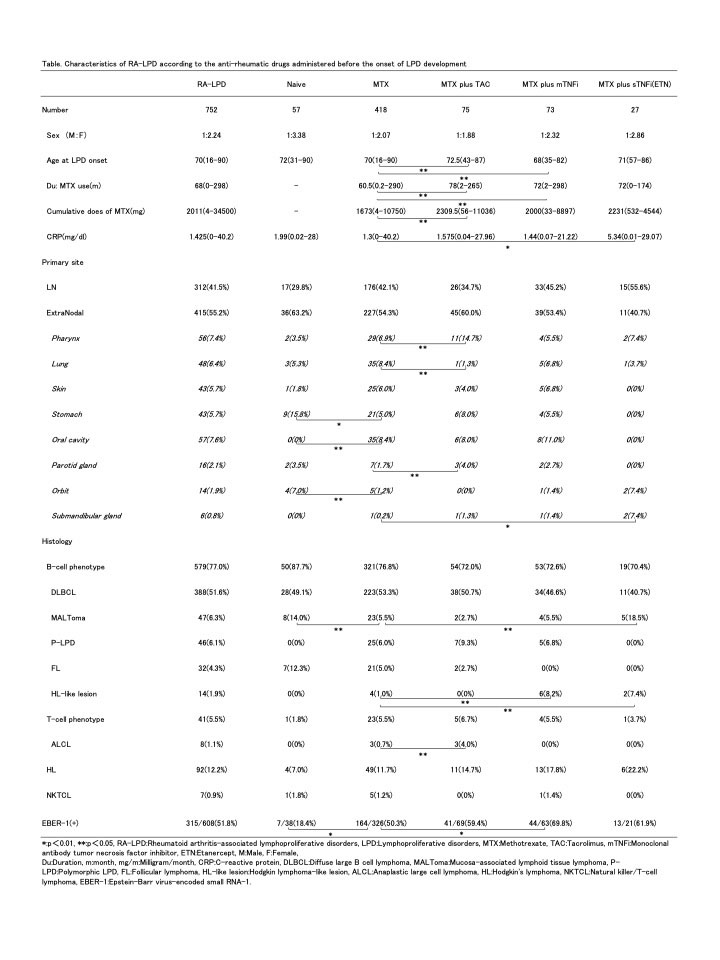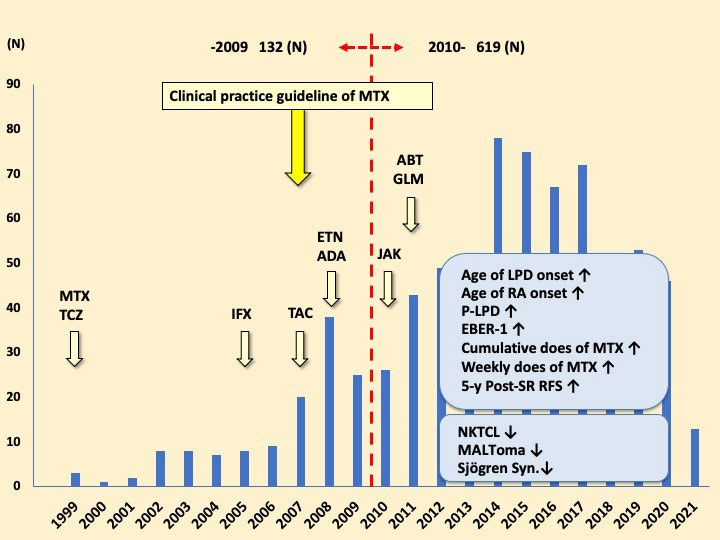Session Information
Date: Monday, November 14, 2022
Title: RA – Treatment Poster IV
Session Type: Poster Session D
Session Time: 1:00PM-3:00PM
Background/Purpose: The effect of antirheumatic drugs on the development of lymphoproliferative disorders (LPDs) in rheumatoid arthritis (RA) patients remains unclear. The current study aimed to characterize the clinicopathological features of LPDs in RA patients (RA-LPD) based on the recent advancement in antirheumatic drugs.
Methods: In this multicenter collaborative study across 48 hospitals in Japan, RA patients who also developed LPDs and visited the hospitals between January 1999 and March 2021 were retrospectively analyzed. The study also enrolled consecutive non-RA patients who developed LPDs (sporadic LPD) for comparative analysis. Significant differences were evaluated using Fisher’s exact test, Mann-Whitney U-test, and log-rank test, and multivariate analysis was performed using logistic regression analysis and Cox-proportional hazard’s models. Statistical significance was set up at p< 0.05.
Results: A total of 752 RA-LPD patients and 770 sporadic-LPD patients were included. We observed statistically significant differences between the clinicopathological features (such as female dominance, increase CRP and LDH levels, and increased EBER-1 positivity) of RA-LPD and sporadic LPD patients. Subtype analysis of the primary sites or histology indicated that the frequencies of LPD-associated immunosuppressive conditions, such as Hodgkin lymphoma (HL), polymorphic LPD (P-LPD), significantly increased. Furthermore, RA-LPD patients were analyzed based on the antirheumatic drug administered before the onset of LPD, and the clinicopathological characteristics differed between the naïve and methotrexate (MTX)-only groups , the MTX-only and MTX plus tacrolimus (TAC) groups, the MTX-only and the monoclonaltumor necrosis factor inhibitor (mTNFi) groups, and the MTX-only and soluble TNFi (sTNFi) groups, respectively (Figure 1, Table 1), as follows.
1) Naïve group vs MTX-only group: The MTX-only group showed significantly higher EBER-1 positivity, increased oral cavity origin, and decreased orbit origin, stomach origins and MALToma histologic subtype.
2) MTX-only vs MTX plus TAC group: The MTX plus TAC group showed a significant increase in the frequency of pharynx origin and ALCL histologic subtype and a decrease in the frequency of of lung origin.
3) MTX-only vs MTX plus mTNFi group: The MTX plus mTNFi group showed a significantly higher frequency of EBER-1 positivity. A high frequency of HL-like lesion was observed in both groups.
4) MTX-only vs MTX plus sTNFi group: Higher frequencies of submandibular gland origin, MALToma and HL-like lesion were observed in the MTX plus sTNF (ETN) group.
When the clinicopathological features of RA-LPD patients were compared between the 1999 to 2009 and 2010 to 2021 periods, immunosuppressive markers such as P-LPD and EBER-1 positivity rates showed an increase in the 2010 to 2021 period (Figure 2). Thus, the clinicopathological characteristics of RA-LPD appear to change over time.
Conclusion: In conclusion, the recent advancement of antirheumatic drugs have influenced the clinicopathological features of RA-LPD. The disease appears to shift from being disease-related to therapy-related.
RA-LPD, lymphoproliferative disorders in rheumatoid arthritis
RA-LPD, lymphoproliferative disorders in rheumatoid arthritis
RA-LPD, lymphoproliferative disorders in rheumatoid arthritis
To cite this abstract in AMA style:
Hoshida Y, Tsujii A, Ohshima S, Saeki Y, Yagita M, Miyamura T, Katayama M, Hiramatsu Y, Oshima H, Murayama T, Higa S, Hirano F, Ichikawa K, Chiba N, Sugiyama T, Ihata A, Mitsuo A, Tsutani H, Takahi K, Okamoto A, Yoshizawa S, Suenaga Y, Mori S, Nagakura S, Yoshikawa N, Ueda A, Nagaoka S, Setoguchi K, Sugii S, Abe A, Sugaya T, Koseto M, Kunugiza Y, Iizuka N, Yoshihara R, Fujisaki T, Sugahara H, Saito I, Kuraoka K, Teramoto N, Ito M, Taguchi K, Minami Y, Naito S, Nomoto M, Saito K, Matsui K, Tomita Y, Furukawa H, Tohma S. Rheumatoid Arthritis Associated Lymphoproliferative Disorders: Current Features and It’s Changing Pattern Due to the Influence of Anti-rheumatic Drugs [abstract]. Arthritis Rheumatol. 2022; 74 (suppl 9). https://acrabstracts.org/abstract/rheumatoid-arthritis-associated-lymphoproliferative-disorders-current-features-and-its-changing-pattern-due-to-the-influence-of-anti-rheumatic-drugs/. Accessed .« Back to ACR Convergence 2022
ACR Meeting Abstracts - https://acrabstracts.org/abstract/rheumatoid-arthritis-associated-lymphoproliferative-disorders-current-features-and-its-changing-pattern-due-to-the-influence-of-anti-rheumatic-drugs/



